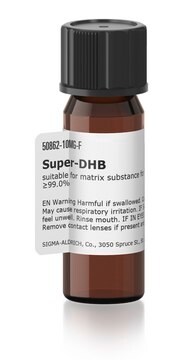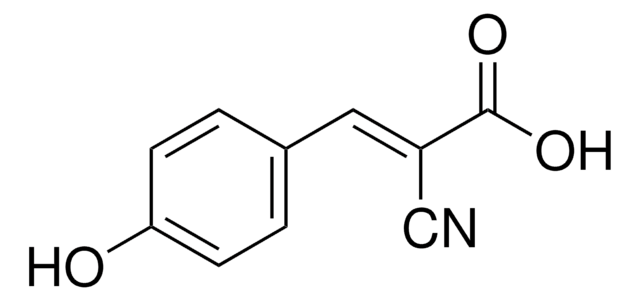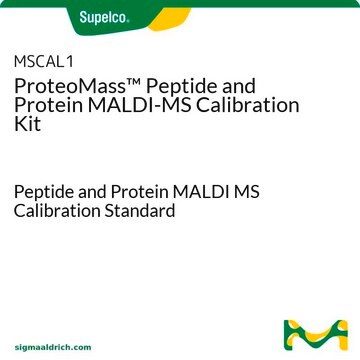49508
Sinapic acid
matrix substance for MALDI-MS, ≥99.5%, Ultra pure
Synonym(s):
3,5-Dimethoxy-4-hydroxycinnamic acid, 4-Hydroxy-3,5-dimethoxy-cinnamic acid, Sinapinic acid
About This Item
Recommended Products
grade
matrix substance for MALDI-MS
Quality Level
assay
≥99.5% (HPLC)
≥99.5%
analyte chemical class(es)
dendrimers, fullerenes, peptides, proteins
technique(s)
MALDI-MS: suitable
mp
~202 °C
solubility
dioxane: 1 g/10 mL at hot, clear, faintly yellow to yellow
cation traces
Al: ≤1 mg/kg
Ba: ≤1 mg/kg
Ca: ≤2 mg/kg
Cd: ≤1 mg/kg
Co: ≤1 mg/kg
Cr: ≤1 mg/kg
Cu: ≤1 mg/kg
Fe: ≤1 mg/kg
K: ≤2 mg/kg
Li: ≤1 mg/kg
Mg: ≤1 mg/kg
Mn: ≤1 mg/kg
Na: ≤2 mg/kg
Ni: ≤1 mg/kg
Sr: ≤1 mg/kg
Zn: ≤1 mg/kg
suitability
in accordance for UV test
suitable for matrix substance for MALDI-MS
SMILES string
COc1cc(\C=C\C(O)=O)cc(OC)c1O
InChI
1S/C11H12O5/c1-15-8-5-7(3-4-10(12)13)6-9(16-2)11(8)14/h3-6,14H,1-2H3,(H,12,13)/b4-3+
Inchi Key
PCMORTLOPMLEFB-ONEGZZNKSA-N
Looking for similar products? Visit Product Comparison Guide
General description
Application
- Metabolic Fate Characterization: Sinapic acid′s metabolic fate in biological systems is a significant area of research. Recent studies in rats have focused on identifying the metabolic pathways and by-products of sinapic acid, using advanced techniques such as liquid chromatography-mass spectrometry (LC-MS). These studies provide insights into its bioavailability and pharmacokinetics, which are crucial for understanding its therapeutic potential (Analytical and Bioanalytical Chemistry, 2023).
- Efficient Extraction from Plant Materials: Sinapic acid is extracted from various plant sources using molecularly imprinted polymers (MIPs) and deep eutectic solvents. These methods enhance the efficiency and selectivity of sinapic acid extraction, making it a valuable approach for analytical chemists working on natural product isolation and characterization. This application is particularly relevant in the food and pharmaceutical industries for quality control and standardization (Food Chemistry, 2023).
- Selective Sensing Applications: Sinapic acid is used in the development of nanocomposites for selective sensing applications. For instance, Ni-sinapic acid nanocomposites have been developed for the selective detection of permanganate ions. This research showcases the versatility of sinapic acid in creating sensitive and specific sensors for environmental monitoring and analytical applications (Journal of Photochemistry and Photobiology A: Chemistry, 2023).
- Bioactivity Studies: The bioactivity of sinapic acid extends to its anti-inflammatory and anticancer properties. Studies have shown that sinapic acid can modulate various biochemical pathways, providing protective effects against inflammation and cancer. These findings underscore its potential as a bioactive compound in therapeutic formulations and highlight the importance of analytical methods in quantifying its efficacy and safety (Stem Cell Research International, 2022).
Biochem/physiol Actions
Packaging
related product
signalword
Warning
hcodes
Hazard Classifications
Eye Irrit. 2 - Skin Irrit. 2 - STOT SE 3
target_organs
Respiratory system
Storage Class
11 - Combustible Solids
wgk_germany
WGK 3
flash_point_f
Not applicable
flash_point_c
Not applicable
ppe
dust mask type N95 (US), Eyeshields, Gloves
Choose from one of the most recent versions:
Certificates of Analysis (COA)
Don't see the Right Version?
If you require a particular version, you can look up a specific certificate by the Lot or Batch number.
Already Own This Product?
Find documentation for the products that you have recently purchased in the Document Library.
Customers Also Viewed
Articles
One of the most important aspects of our ultra-pure MALDI matrix substances is their ability to dissolve rapidly and completely; a brief vortex mixing is typically sufficient.
Our team of scientists has experience in all areas of research including Life Science, Material Science, Chemical Synthesis, Chromatography, Analytical and many others.
Contact Technical Service





![trans-2-[3-(4-tert-Butylphenyl)-2-methyl-2-propenylidene]malononitrile matrix substance for MALDI-MS, ≥99.0% (HPLC)](/deepweb/assets/sigmaaldrich/product/structures/249/587/f8021369-f65a-413d-887d-3c8a4d2a248f/640/f8021369-f65a-413d-887d-3c8a4d2a248f.png)




